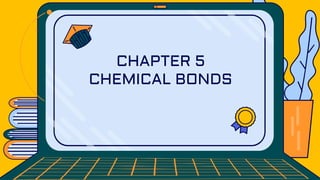
FORMATION OF COVALENT BOND
- 2. 5.3.1 Explain with examples the formation of covalent bond 5.3.2 Compare ionic and covalent bonds 5.3 Covalent bond
- 3. 5.3.1 Explain with examples the formation of covalent bond State the meaning of covalent bond Explain formation of covalent bond Illustrate the formation of covalent bond by drawing electron arrangement Illustrate formation of covalent bond 5.3 Covalent bond
- 4. Formation of covalent bond
- 5. Single Bond o A single bond is formed when two atoms shared a pair of electrons. o Example : The hydrogen molecule, H2 o A hydrogen atom has one valence electron. o It needs one more electron to achieve duplet electron arrangement. o Therefore two hydrogen atoms contribute one electron each for sharing. o This shared-pair of electrons forms a single bond in the hydrogen molecule, H2. 1 Hydrogen atom, H 1 Hydrogen atom, H + A shared pair of electrons
- 6. Formation of Covalent Bond ● Covalent bonds are formed when non-metals atoms share their electrons to achieve a stable duplet or octet electron arrangement. ● There are three types of covalent bonds; single bond, double bond and triple bond
- 7. Single Bond Single bond o A single covalent bond is formed when two atoms shared a pair of electrons.
- 8. Single Bond - Lewis Structure ● The formation of covalent bond can be visualized using the Lewis structure. ● Lewis structure only shows the valence electrons of the atoms involved. ● A pair of electrons shared is represented with a line between the two atoms.
- 9. Double Bond Double bond o A double bond is formed when two atoms share two pairs of electrons.
- 10. Triple Bond Triple bond o A triple bond is formed when two atoms share three pairs of electrons
- 11. EXPLAIN THE FORMATION OF CHLORINE MOLECULE 1. Chlorine atom with an electron arrangement 2.8.7 needs one electron to achieve a stable octet electron arrangement. 2. Two chlorine atoms share one pair of electrons to achieve a stable octet electron arrangement, forming a chlorine molecule. 3. Each chlorine atom achieves stable octet electron arrangement. 4. The number of electron pairs shared is one pair. Single covalent bond is formed.
- 12. EXPLAIN THE FORMATION OF OXYGEN MOLECULE 1. Oxygen atom with an electron arrangement 2.6 needs two electrons to achieve a stable octet electron arrangement. 2. Two oxygen atoms share two pairs of electrons to achieve a stable octet electron arrangement, forming an oxygen molecule. 3. Each oxygen atom achieves stable octet electron arrangement. 4. The number of electron pairs shared is two pairs. Double covalent bond is formed. 2.6 Oxygen atom, O 2.6 Oxygen atom, O Oxygen molecule, O2
- 13. EXPLAIN THE FORMATION OF OXYGEN MOLECULE 1. Nitrogen atom with an electron arrangement 2.5 needs three electrons to achieve a stable octet electron arrangement. 2. Two nitrogen atoms share three pairs of electrons to achieve a stable octet electron arrangement, forming a nitrogen molecule. 3. Each nitrogen atom achieves stable octet electron arrangement. 4. The number of electron pairs shared is three pairs. Triple covalent bond is formed.
- 14. FORMATION OF COVALENT COMPOUND (Hydrogen chloride, HCl) 1. Hydrogen atom with an electron arrangement 1 needs one electron to achieve a stable duplet electron arrangement. 2. Chlorine atom with an electron arrangement 2.8.7 needs one electron to achieve stable octet electron arrangement. 3. One chlorine atom shares one pair of electrons with one hydrogen atom to form hydrogen chloride molecule with formula HCl. 4. One chlorine atom contributes one electron and one hydrogen atom contributes one electron for sharing. 5. One chlorine atom forms one single covalent bond with one hydrogen atom. 6. Chlorine atom achieves stable octet electron arrangement and hydrogen atom achieve duplet electron arrangement.
- 15. 5.3.2 Compare ionic and covalent bonds Compare and contrast formation of ionic and covalent bonds 5.3 Covalent bond
- 16. COMPARISON BETWEEN IONIC BOND AND COVALENT BOND SIMILARITIES 1. Formation of ionic bond and covalent bond involves valence electrons only. 2. Atoms form ionic bond and covalent bond to achieve a stable octet electron arrangement. DIFFERENCES Ionic Bond Covalent Bond Ionic bond involves transfer of electrons. Electrons Covalent bond involves sharing of electrons. Electrons are released by metal atoms and received by non-metal atoms. Pairs of electrons are shared by the same or different non-metal atoms. Between metal atoms and non-metal atoms. Type of element involved Between non-metal atoms and non-metal atoms. Metal atoms form a positively-charged ion. Non-metal atoms form a negatively- charged ion. Type of particle formed Forms a molecule Lead(II) bromide, PbBr2 ; sodium chloride, NaCl ; copper(II) sulphate, CuSO4 Example of ionic and covalent compounds Naphthalene, C8H10 ; Acetamide, CH3CONH2 ; Hexane, C6H14
- 17. COMPARISON BETWEEN IONIC BOND AND COVALENT BOND DIFFERENCES Ionic Bond Covalent Bond Electron arrangement in the particles. Ionic bond is the strong electrostatic force of attraction between positively-charged ion and negatively-charged ion. Covalent bond is the shared pairs of electrons between atoms in a molecule. Strong covalent bond between atoms in the molecules. Strong electrostatic forces between ions 1- 1- 2+
